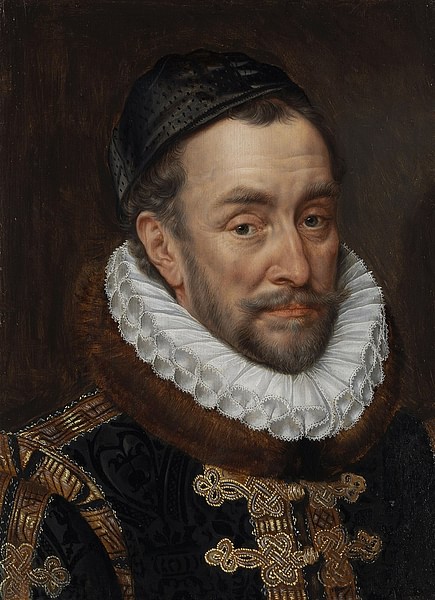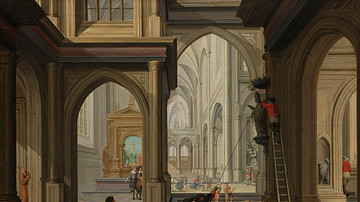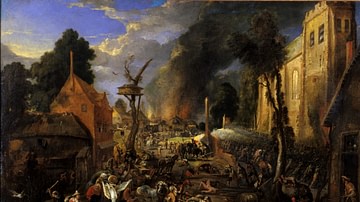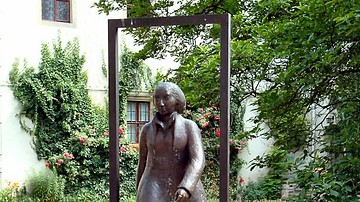
William the Silent (l. 1533-1584, also known as William of Orange) was the leader of the Dutch Revolt (the Eighty Years' War) in the Netherlands; first politically (between 1559-1568) then militarily (between 1568-1584). He is among the most prominent figures in Dutch history, regarded as the Father of the Fatherland, and in European history of the 16th century.
William was a stadtholder (administrator/steward) for King Philip II of Spain (r. 1556-1598) who ruled the Low Countries (Netherlands) after his father, Charles V, Holy Roman Emperor (r. 1519-1556) abdicated. Charles V had introduced the Inquisition into the Low Countries to suppress what he considered the heresies of the Protestant Reformation, and Philip II continued his policies but with far greater determination and severity. He first appointed Cardinal Antoine Perrenot de Granvelle (l. 1517-1586) to head the Inquisition and then turned the task over to Fernando Álvarez de Toledo, 3rd Duke of Alba (l. 1507-1582) in 1567, whose persecutions resulted in the deaths of thousands and William's flight to his hometown of Dillenburg.
William organized a resistance, and he returned in 1568, leading the Dutch Protestant forces against those of Catholic Spain until his assassination in 1584. Leadership then fell to his son, Maurice of Orange (l. 1567-1625), then another son, Frederick Henry (l. 1584-1647), who furthered his father's agenda until his death one year before the end of the Eighty Years' War and full Dutch independence.
William the Silent is not only famous as the great-grandfather of William of Orange, King of England, Scotland, and Ireland but also for consistently fighting for religious and personal freedom and establishing the independent Dutch Republic. He is honored today as the Father of the Netherlands, through their national anthem, the Wilhelmus, and in many other ways by various nations.
Early Life & Religion
William was born in Dillenburg, part of the Germanic territories of the Holy Roman Empire, on 24 April 1533, the eldest son of William I, Count of Nassau-Dillenburg (l. 1487-1559) and Juliana, Countess of Stolberg (l. 1506-1580), who would have twelve children together (as well as others from their previous marriages). His parents had both been raised Catholic but converted to Lutheranism at some point prior to his birth. He was raised Lutheran but, in 1544, his first cousin, Prince of Orange René de Chalon (l. 1519-1544), stadtholder of the Low Countries of Holland, Geire, Utrecht, and Zeeland, died and left him his entire estate with the stipulation that he must convert to Roman Catholicism and be educated in the faith.
William's father agreed to the condition, sending him to the Low Countries for his education, while Charles V served as regent for the districts and director of the estate until William came of age. He received a complete education, commensurate to his social standing, including languages, history, and religion as well as military skills, courtly diplomacy, and the arts of political intrigue.
William's later stand for religious freedom and expression is usually traced directly back to the religious diversity of his youth. In 1551, he married the Catholic Anna van Egmont (l. 1533-1558), daughter of Maximilian van Egmont, commander of Charles V's army, and received the title of Lord of Egmont, Count of Buren. His conversion to Catholicism clearly impressed upon him the usefulness of religion in personal and political gain. William's choice to continue as a Catholic was motivated as much by professional concerns as any deep conviction. He would periodically use religion in furthering his political goals, which has led some historians to doubt his religious convictions, but he seems to have regarded the issue of Protestant vs. Catholic as a non-issue as he had experienced both first-hand.
After Anna died of disease in 1558, William mourned her as theirs had been a happy marriage, but then pursued Anna of Saxony (l. 1544-1577) primarily for her wealth, using religion to ingratiate himself with her family. Scholar K. W. Swart comments:
In his early years, religious questions meant little to him. In 1560, when he was determined to marry the Protestant princess Anne of Saxony, he assured her powerful German relatives that he was a Protestant at heart, while at the same time declaring to Philip II that nothing was as dear to him as the Catholic religion. He spoke more truthfully a few years later when he stated that Catholics and Protestants basically professed the same faith, even if they expressed their belief in different ways. (Hermans & Salverda, 48)
His religious tolerance (sometimes characterized as indifference) would inform his political and military career from the beginning and, eventually, contribute to his assassination. It is also said that it gave him the epithet "the Silent" as, according to the best-known account, on a hunting trip with the Catholic Henry II of France (r. 1547-1559), the king disclosed to him an agreement between himself and the Duke of Alba to exterminate the Protestants, thinking that William was already aware of the plot, and William, remaining silent, allowed him to continue in that belief to thwart the plan. This account is contested, however, as he was not known as William the Silent by his admirers until years after his death when this story first appears. According to Swart, he was known as "the Silent" for never revealing his true political agenda to anyone.
Religious Divisions in the Netherlands
Whatever his personal feelings toward his faith, William was outwardly a devout Catholic and a favorite of Charles V, rapidly advancing as a military commander and receiving the commission as sole commander of an army by 1555. At this time, Charles V turned control of the Low Countries over to his son Philip II due to illness (he would fully abdicate the following year), but his decision was also informed by the religious dissension that had increasingly become a problem since the 1540s.
The 'new teachings' of the Reformation had first been brought to the Netherlands by the Anabaptists, a Protestant sect inspired by the Reformed vision of Huldrych Zwingli (l. 1484-1531), c. 1530. The Anabaptist evangelist Melchior Hoffman (l. c. 1495 - c. 1543) denounced Catholicism as satanic and encouraged his followers to kill those who were not of the 'true faith'. His followers, known as Melchiorites, destroyed Catholic churches and iconography across the Netherlands between 1531-1535, leading to Charles V's imposition of the Inquisition and the execution of approximately 30,000 Anabaptists as well as those of other Protestant sects between 1537-1547.
In the 1540s, Calvinism was introduced to the Netherlands, spreading the vision of John Calvin (l. 1509-1564), and inspiring the same division and violence. Charles V had already experienced this kind of social unrest in the Holy Roman Empire after Martin Luther (l. 1483-1546) had established the Reformation's message in Wittenberg in 1517 and so tried to curb the same in the Netherlands. In 1555, he turned the problem over to his son. One of Philip II's first acts was to issue the Edict of 1556, a continuance of Charles V's "Edict of Blood" of 1550, outlawing all Protestant sects and decreeing the death penalty and confiscation of property for anyone engaging in or encouraging Protestant heresies.
Political Leadership
William objected to Philip II's edict as well to Cardinal Granvelle whose Inquisition often seemed to serve his personal interest in collecting fine art from accused 'heretics' as much as Philip II's agenda to stamp out heresy in the Netherlands. William aligned with the nobles Philip de Montmorency, Count of Horn (l. c. 1525-1568), and Lamoral, Count of Egmont (l. 1522-1568), in diplomatically opposing Philip II's edict and calling for an end to the Inquisition and the removal of Granvelle. Swart writes:
It is understandable that a person who attached so little significance to the confessional controversies of his period, and whose closest relatives and best friends, as well as his wife, were Protestants, was utterly opposed to Philip II's merciless persecution of heretics. (Hermans & Salverda, 48)
By 1564, Philip II had come to question William's loyalty as well as the sincerity of his alleged Catholic convictions. William was able to avoid a confrontation with Philip II by directing his criticisms at Granvelle, but in 1564, he openly declared himself in favor of religious tolerance and, in the speech given at the Council of State, denounced the Edict of 1556, rejecting the claim that any monarch had the right to dictate the religious beliefs and observances of their subjects.
Granvelle was recalled to Spain that same year after the petitions of William, Montmorency, and Egmont were finally accepted by the Governor of the Netherlands, Margaret of Parma (l. 1522-1586, illegitimate daughter of Charles V), who also agreed to their points on religious freedom. In 1566, however, the Protestants (primarily the Calvinists) launched the Beeldenstorm ("statue storm"), also known as the Iconoclastic Fury, during which they destroyed Catholic artwork, churches, monasteries, and icons across the country. Margaret appealed to William to resolve the violence, but by this time, Philip II had already ordered the Duke of Alba to the region to establish order, and when he arrived in 1567, he implemented the Inquisition on a scale Granvelle never approached by establishing the Council of Troubles, which resulted in so many executed it came to be referenced as the "Council of Blood".

William knew Alba personally as they had served together earlier in foreign wars for Spain and, in spite of the tensions between William and Philip II, he was still a stadtholder in good standing. Even so, he was called to appear before the Council of Troubles, and when he did not appear, he was declared an outlaw. He fled to Dillenburg while Montmorency and Egmont remained. They were convicted by the council and executed in 1568. Scholar Diarmaid MacCulloch comments:
William was now forced into the leadership of the opposition by the power vacuum which the executions created and by the wrongs personally afforded him by Alba's administration. He concluded an alliance with the French Huguenot leaders Coligny and the Prince of Condé. (312)
Admiral of France, Gaspard II de Coligny (l. 1519-1572), and Louis de Bourbon, Prince of Condé (l. 1530-1569), were two of the most powerful leaders of the French Protestant (Huguenot) forces engaged in the French Wars of Religion (1562-1598). The second of these wars (1567-1568) had just concluded when William approached them, and they were able to offer assistance. From this point on, William was the military leader of the Dutch Protestant forces.
Military Leadership & The Goals
William placed his brother Louis in command of the Huguenot forces whose invasion of the Low Countries failed when they were defeated and their plans captured. The mercenaries William recruited seemed to do more harm than good and overall, as MacCulloch observes, "William's efforts at military action against Alba were a failure" (312). The third of the French Wars of Religion began the summer of 1568, so no further aid could be expected from Coligny or Condé, and William's forces were no match for the highly trained Spanish soldiers under Alba. William's brothers Louis and Adolf of Nassau had led Dutch forces to victory at the Battle of Heiligerlee on 23 May 1568, but Alba defeated Louis in July at the Battle of Jemmingen, scattering his army. In the initial engagements of the Eighty Years' War, victory would consistently go to Alba.
Between 1568-1572, Alba either won a direct engagement or prevented William from advancing his agenda. In 1572, in hopes of winning more widespread support from the populace and, just as importantly, clarifying that he was not at war with Philip II but with Alba's administration, William issued his writ The Goals of William of Orange which reads, in part:
I have only the following objectives in this war: That with full respect for the king's sovereign power, all decrees contrary to conscience and to the laws shall be annulled and that everyone who so wishes shall be free to adopt the teaching of the prophets, of Christ, and the apostles, which the Churches have taught until now and that those who reject these doctrines may do so without any injury to their goods as long as they are willing to behave peacefully and can show that they did so in the past.
That the name of the Inquisition shall be erased forever…
That people be given back their houses, possessions, hereditary estates, their good name, their freedoms, privileges, and laws by which liberty is maintained…
That political matters will be dealt with by the king himself and by the States which are chosen in every province and not be dispatched secretly by hired foreigners through whose faithlessness and greed the present troubles have come about…
I pray you once again, because of the loyalty which you and I owe to our dearest fatherland, that with my help you rescue, take back, and protect, what you do not want to lose forever… (Lindberg; Source 11.10, p. 202)
The writ encouraged the spirit of nationalism among the people who directed their resentment at Alba, not Philip II, and, fortuitously for William, at this same time the privateers known as the Sea Beggars, who had been expelled from England, landed in the north, capturing the cities of Brill and Vlissingen, which then became Protestant bases.
In 1573, Alba was recalled to Spain and replaced by Luis de Requesens y Zúñiga (l. 1528-1576), who tried to forge a peace with William, but the stipulation that only Roman Catholicism would be allowed ended any negotiations. Requesens died in 1576, the same year The Pacification of Ghent was signed, expelling Spanish mercenary troops from the Low Countries who had been sacking cities in lieu of pay. The Pacification was a major political and military win for William who, by this time, controlled most of the northern Netherlands. Requesens was replaced by Philip II's half-brother John of Austria (l. 1547-1578), and after his death, by Alexander Farnese, Duke of Parma (l. 1545-1592), who reclaimed cities throughout the south and established strong Catholic bases.
Later Marriages, Independence, & the French Debacle
By this time (1579), William had divorced his second wife on the grounds of adultery and mental infirmity in 1571, had formally converted to Calvinism in 1573, founded the University of Leiden in 1575 and, that same year, married Charlotte of Bourbon (l. c. 1547-1582), a former nun who, inspired by the Protestant Queen of Navarre, Jeanne d'Albret, had left her convent and converted to Calvinism. The couple had six daughters, including the Countess Louise Juliana of Nassau (l. 1576-1644), probably best known as the savior of Berlin during the Thirty Years' War.
The years of Williams' third marriage were probably his happiest and certainly his most successful as, in addition to winning a number of military engagements and securing the north, he was instrumental in the signing of the Union of Utrecht in 1579, founding the Republic of the Seven United Provinces (eventually the Dutch Republic) and declaring the northern Netherlands an independent nation. Spain now only controlled the southern provinces, as they would continue to even after the war.
Philip II had, before this time, placed a large bounty on his head, and an attempt was made on his life by Juan de Jauregui in March 1582. William was shot at close range in the back of the neck below his right ear, the bullet then passing through and out his left jaw. Jauregui was killed instantly, and William was nursed back to health by Charlotte who died afterwards in 1583, apparently from the stress of caring for him.
William then married Louise de Coligny (l. 1555-1620), daughter of Admiral Coligny (who had been killed in St. Bartholomew's Day Massacre in 1572). She would be the mother of Frederick Henry, who completed his father's vision of Dutch independence. William was at the height of his popularity and success when, in an attempt to find a legitimate ruler to take the place of Philip II, he invited Francis, Duke of Anjou and Alençon (l. 1555-1584) to the Netherlands. Francis, displeased with his position, decided to enlarge his holdings and invaded Antwerp in 1583. His troops were massacred by the citizens, and he returned home in disgrace, while William suffered a loss in prestige after the fiasco.
Conclusion
He was still highly regarded when he was assassinated by the Catholic Balthasar Gerard on 10 July 1584, another who was hoping to claim the bounty offered by Philip II. He fired two pistols into William's chest at close range, conferring upon him the dubious honor of the first head of state assassinated by a handgun. Gerard was apprehended and tortured to death but was later declared a martyr by the Catholics, just as William was by the Protestants.

William was succeeded by his son Maurice and then by Frederick Henry, who saw the war through until his death in 1647, one year before the Eighty Years' War concluded with the Peace of Westphalia in 1648 and full Dutch independence. Frederick Henry's grandson would be William III of England (aka William of Orange, l. 1650-1702), King of England, Scotland, and Ireland, stadtholder of the provinces of the Dutch Republic, and a champion of Protestantism.
William the Silent is honored throughout the Netherlands today as the Father of the Fatherland and the colors of the nation's flag are an homage to those of his own. The Netherlands adopted orange as the national color, and his contributions are honored through the national anthem of the Wilhelmus. He remains one of the most engaging and well-respected figures of his time, especially noted for his devotion to freedom and religious tolerance.







